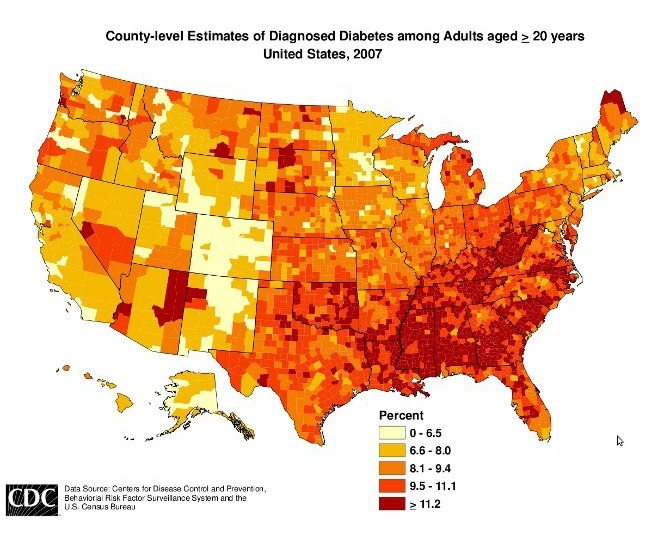Key points
Data sources
This map was created as part of a series of maps displayed on the Division of Diabetes Translation web site showing rates of diagnosed diabetes and related risk factors. County-level maps for each state are also available on the web site. These maps document the geographic disparities that exist in diagnosed diabetes across the United States. They are intended to be used to inform policy makers and researchers about the disproportionate geographic burden of diagnosed diabetes in the U.S.
The purpose of the map is to show the burden of diabetes. Findings are reported in Gregg EW, Kirtland KA, Cadwell BL, Burrows NR, Barker LE, Thompson TJ, Geiss LS, Pan L. Estimated county-level prevalence of diabetes and obesity–United States, 2007. MMWR 2209;58(45):1259-1263.
ArcGIS 9.3 ESRI
Centers for Disease Control and Prevention Behaviorial Risk Factor Surveillance System, and U.S. Census Bureau Population Estimates.
The prevalence of diagnosed diabetes by county was estimated using data from CDC’s Behavioral Risk Factor Surveillance System (BRFSS) and data from the U.S. Census Bureau’s Population Estimates Program.1 The BRFSS provided state-specific information on behavioral risk factors and preventive health practices. Respondents were considered to have diabetes if they responded “yes” to the question, “Has a doctor ever told you that you have diabetes?” Women who indicated that they only had diabetes during pregnancy were not considered to have diabetes. Three years of data were used to improve the precision of the year-specific county-level estimates of diagnosed diabetes estimates. Estimates were restricted to adults 20 years of age or older to be consistent with population estimates from the U.S. Census Bureau, which provides year-specific county population estimates by demographic characteristics. The county-level estimates for the 3,141 counties or county equivalents in the 50 U.S., states and the District of Columbia were based on indirect model-dependent estimates. The model-dependent approach employed a statistical model that “borrows strength” in making an estimate for one county from BRFSS data collected in other counties. Bayesian multilevel modeling techniques were used to obtain estimates. Separate models were developed for each of the four census regions: West, Midwest, Northeast and South. Multilevel Poisson regression models with random effects of demographic variables (age 20–44, 45–64, 65+; race; sex) at the county-level were developed. State was included as a county-level covariate.
Karen Kirtland, Data Analyst, Division of Diabetes Translation
(770) 488-8518
gon6@cdc.gov
2007 Estimates of the Percentage of Adults with Diagnosed Diabetes Division of Diabetes Translation, Center for Disease Control and Prevention. Accessed from the Centers for Disease Control and Prevention's Chronic Disease Map Gallery.

